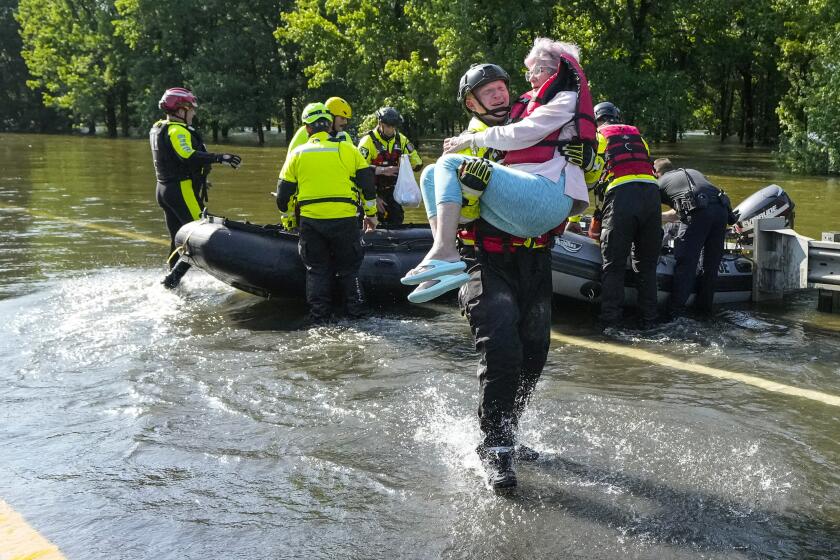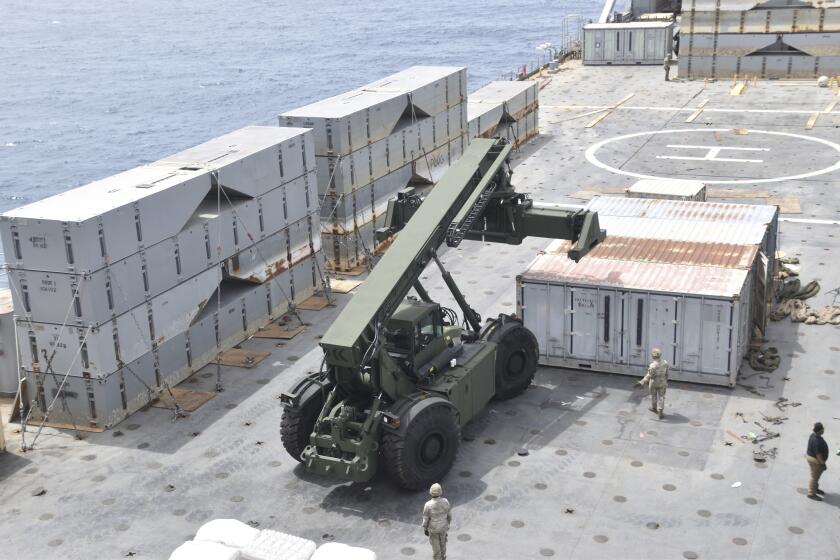Space Station May Hang in Balance
The loss of the space shuttle Columbia and the potential long-term grounding of the rest of the shuttle fleet could doom the partially completed international space station, the heart of NASA’s efforts to send humans into the cosmos.
The $100-billion project relies solely on the shuttle fleet to ferry the tons of parts -- trusses, solar panels, lab modules and dorm rooms -- needed to complete the project. The three remaining shuttles are the only vehicles large enough to carry construction parts to the lab orbiting 240 miles above Earth.
“The space station and the space shuttle are twins joined at the hips. Anything that goes wrong with one affects the other,” said Howard McCurdy, a space policy expert at American University.
NASA officials stressed Sunday the agency has no plans to immediately decommission the station or evacuate the crew. The agency said Russian vehicles could supply the three astronauts there now with fresh food and a means of escape in an emergency.
“We don’t want to leave it unmanned, because we’re exploring. We’re doing science. We have a mission,” said Bob Cabana, the operations director for the shuttle flight crews. “It just wouldn’t be right to quit.”
Only a fraction of the space station has been completed. Many of the scientific laboratory modules remain on the ground, and equipment needed to run experiments is not in place. Fewer than half of the station’s power systems have been installed. The station is as big as a football field and weighs just under 400,000 pounds. If completed as planned, it will be twice as big and weigh about 1million pounds.
NASA had planned five shuttle missions this year to add major pieces to the growing station. The ill-fated Columbia had been scheduled to make its first trip to the station in November, carrying a truss segment.
The delay pushes back even further the completion of the station, which had stretched in recent years from 2004 to 2008 because of a slowdown in shuttle launches and problems with Russian and Japanese components. Adding further problems, routine maintenance and repair tasks could stack up if the station is left unattended, adding to the cost and time needed to finish.
Worst-Case Scenario
In the worst-case scenario, space station managers will face more than just a delay.
“I don’t think it’s a given that we’ll fly the shuttle again,” said John Pike, director of GlobalSecurity.org, a space and defense research firm in Alexandria, Va. “If it turns out the problem is easy and cheap to repair, they would probably default to flying the shuttles. But, on the other hand, if it is a big problem that takes a lot of money and time to fix, they will have to do the math and figure out whether to fix the shuttle or build a replacement.”
No replacement is on the horizon. NASA has canceled several proposed shuttle alternatives because of cost and engineering problems. NASA considered breakthrough technology like the wedge-shaped, rocket-propelled X-33 space plane but abandoned the effort when it encountered setbacks in developing the revolutionary propulsion system. Efforts to make spacecraft with modest, evolutionary improvements were never attempted by NASA, leaving the agency with only 1970s shuttle technology.
More recently, NASA’s new administrator, Sean O’Keefe, recommended pursuing a less ambitious orbital plane to ferry crew, but not large cargo, to the station. The shuttle would remain the main workhorse until 2020.
Shuttle program manager Ron Dittemore said Sunday the space agency “intends to continue flying this vehicle system long into the future,” but said no launches would occur until questions about Columbia’s destruction had been answered.
Shuttles were grounded for 2 1/2 years after the explosion of the Challenger in 1986, even though the problem -- brittle O-rings that allowed hot gases to burn through an external fuel tank and trigger an explosion -- was discovered relatively early in the process.
Ground control cameras recorded the entire event, giving investigators crucial evidence.
Experts said this investigation could take far longer because clues are murkier. Columbia broke apart 207,000 feet above ground, leaving investigators with only small bits of debris and little visual information.
“There isn’t any immediately available evidence from the ground of what went wrong,” said David Acheson, a New York attorney who served on the commission that investigated the Challenger explosion. “This is going to be a long investigation.”
The Shining Hope
The space station, long the shining hope of NASA’s human space exploration program, was promoted throughout the 1980s and early 1990s as a potential platform for the human exploration of Mars and a powerful micro-gravity laboratory to create profitable new manufacturing processes, and to search for cures for AIDS and cancer. It was supposed to cost $8 billion.
Construction started in 1998. Estimates are that the cost of building, maintaining and sending shuttles to the station will swell to $100 billion by the time it is finished.
The cost overruns have been a frequent target of scathing reviews by the General Accounting Office. There have been 22 floor votes called in Congress to kill the station, but it always survived.
The station has been scaled down from its original size. In 2001, with NASA facing a $5-billion cost overrun, agency leaders decided not to add a seven-person lifeboat and a U.S.-built dormitory module that would have allowed seven astronauts to live aboard the station. Instead, the station can support a crew of three -- about the bare minimum for upkeep and domestic chores.
Astronauts have started to complain that they are housekeepers, not scientists.
The schedule leaves a three-person crew working nearly all of the time with just 10 hours a week for experiments. In addition, construction cost overruns have eaten into the science budget, leading many scientists to say the station no longer serves its original purpose.
“The international space station is yesterday’s technology,” Robert Park, a physicist at the University of Maryland, said during one of a series of congressional hearings held in recent years to consider killing or scaling back the project. “Another 10 years of urine assays on a space station is not going to tell us much we don’t already know.”
Supporters say the station played a positive role in maintaining relationships between the U.S. and Russia during the tense years at the end of the Cold War, and continues to cement relationships among the 16 nations involved. Proponents of human space flight consider the station an essential part of any future mission to explore planets.
It would be worth continuing the investment even if the station has to be evacuated and mothballed while shuttles are grounded, said John Logsdon, who directs the Space Policy Institute at George Washington University. He dismissed discussion of the death of the space station as premature.
“You could put it in a safe mode for a year to a year and a half without deorbiting it,” said Logsdon, who remained hopeful that shuttles could resume flying by then. “You can still send new crews up on Soyuz or new supplies up on [the Russian unmanned] Progress vehicles.”
Russian officials told the Interfax news agency they could only launch three resupply ships this year, fewer than what would be needed with no shuttle flights.
“Russia is short of funds and will not be able to build the required number of Soyuz and Progress space ships that are necessary for the trouble-free functioning of the ISS,” said Boris Y. Chertok, a pioneer of the Soviet space program and consultant to Energiya Design Bureau, the corporation that builds most Russian space vehicles.
Other Russian space officials said if they were given funding, they could use Russian Proton-heavy rockets to complete the station, something they see as a high priority.
The loss of the Columbia “is not a tragedy for the U.S. alone,” Chertok said. “It is a tragedy for the entire international program of space flight.”
Duke University historian Alex Roland, a former NASA historian, said the agency should abandon plans to keep the station permanently inhabited and instead should turn it into a “space platform” that would occasionally be visited by astronauts for maintenance and to install experiments that could be left unattended.
Russian Aviation and Space Agency spokesman Sergei Gorbunov said Sunday he would be concerned about the fate of the station if NASA officials decided to leave it unmanned for any length of time.
“It is possible to lose control over such a big station without permanently working cosmonauts in orbit,” he said.
No one is giving up hope. NASA has repeatedly resurrected itself after devastating failures.
The Apollo program to reach the moon resumed 19 months after a launch-pad fire claimed the life of three astronauts. The shuttle Discovery took off in September 1988, 2 1/2 years after Challenger exploded.
“We owe it to all of us -- the American people -- to determine exactly what occurred, make corrections and make sure that we support the brave crew that’s aboard international space station right now and send a new one up,” NASA’s O’Keefe said. “That’s a continuous presence in space, an effort that we’re still dedicated to.”
*
David Holley and Alexei V. Kuznetsov of the Times Moscow bureau and Times staff writer Richard O’Reilly contributed to this report.
More to Read
Start your day right
Sign up for Essential California for news, features and recommendations from the L.A. Times and beyond in your inbox six days a week.
You may occasionally receive promotional content from the Los Angeles Times.







